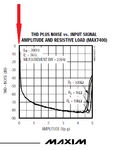Jester
Full Member level 6
I'm working on an audio circuit with a frequency response of 600 - 3000Hz. The input signal has significant high frequency noise (sounds like 10kHz white noise). An 8th order SCF (MAX7400) with a cutoff of 3kHz has little effect audio wise, however if I inject a signal and measure the attenuation of the filter the signal is down by 50dB before 4kHz at the output of the filter. So the filter is working, however the background noise (when I listen with an audio amplifier) seems about the same at the input and output of the filter, the tone of the nose changes slightly but that's about it.
Looking at the signal with a scope there is significant noise at the SCF oscillator frequency of 300kHz (10mVp-p), and some even higher frequency, lower level noise ~0.5mV at perhaps 1MHz but nothing obvious at lower frequencies. So I can't see what I hear.
One more thing if I listen with my amplifier to the Vcc line feeding the SCF and opamps the noise sounds almost identical the the filter output. If I listed to ground, it's silent.
Any suggestions?
Looking at the data sheet, does this graph imply that with really low signal levels (my problem case) that the filter does little to nothing (see red arrow)

Looking at the signal with a scope there is significant noise at the SCF oscillator frequency of 300kHz (10mVp-p), and some even higher frequency, lower level noise ~0.5mV at perhaps 1MHz but nothing obvious at lower frequencies. So I can't see what I hear.
One more thing if I listen with my amplifier to the Vcc line feeding the SCF and opamps the noise sounds almost identical the the filter output. If I listed to ground, it's silent.
Any suggestions?
Looking at the data sheet, does this graph imply that with really low signal levels (my problem case) that the filter does little to nothing (see red arrow)

Last edited:

